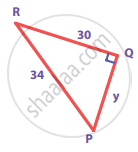Advertisements
Advertisements
Question
The sides of the triangle are given below. Find out which one is the right-angled triangle?
8, 15, 17
Solution
It is known that, if in a triplet of natural numbers, the square of the biggest number is equal to the sum of the squares of the other two numbers, then the three numbers form a Pythagorean triplet. If the lengths of the sides of a triangle form such a triplet, then the triangle is a right-angled triangle.
The sides of the given triangle are 8, 15, and 17.
Let us check whether the given set (8, 15, 17) forms a Pythagorean triplet or not.
The biggest number among the given set is 17.
(17)2 = 289; (15)2 = 225; (8)2 = 64
Now, 225 + 64 = 289
∴ (15)2 + (8)2 = (17)2
Thus, (8, 15, 17) forms a Pythagorean triplet.
Hence, the given triangle with sides 8, 15, and 17 is a right-angled triangle.
RELATED QUESTIONS
PQR is a triangle right angled at P and M is a point on QR such that PM ⊥ QR. Show that PM2 = QM . MR
O is any point inside a rectangle ABCD.
Prove that: OB2 + OD2 = OC2 + OA2.
M andN are the mid-points of the sides QR and PQ respectively of a PQR, right-angled at Q.
Prove that:
(i) PM2 + RN2 = 5 MN2
(ii) 4 PM2 = 4 PQ2 + QR2
(iii) 4 RN2 = PQ2 + 4 QR2(iv) 4 (PM2 + RN2) = 5 PR2
Find the Pythagorean triplet from among the following set of numbers.
4, 5, 6
Find the length of the perpendicular of a triangle whose base is 5cm and the hypotenuse is 13cm. Also, find its area.
In a triangle ABC, AC > AB, D is the midpoint BC, and AE ⊥ BC. Prove that: AC2 - AB2 = 2BC x ED
The perpendicular PS on the base QR of a ∆PQR intersects QR at S, such that QS = 3 SR. Prove that 2PQ2 = 2PR2 + QR2
Find the unknown side in the following triangles
The perimeters of two similar triangles ABC and PQR are 60 cm and 36 cm respectively. If PQ = 9 cm, then AB equals ______.
Two squares having same perimeter are congruent.
